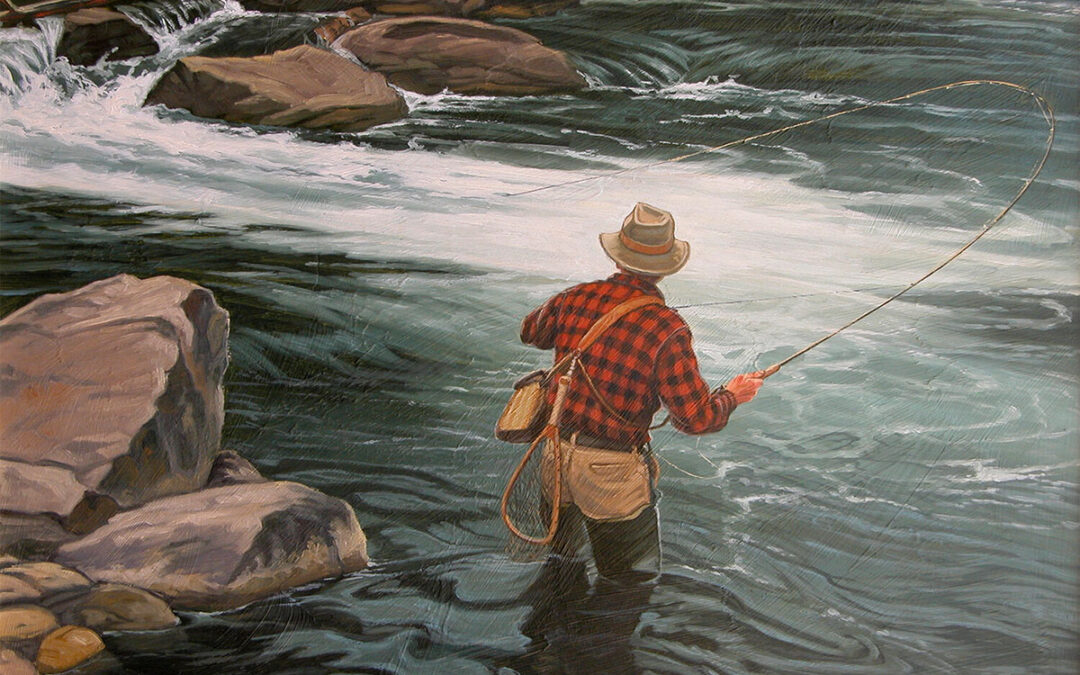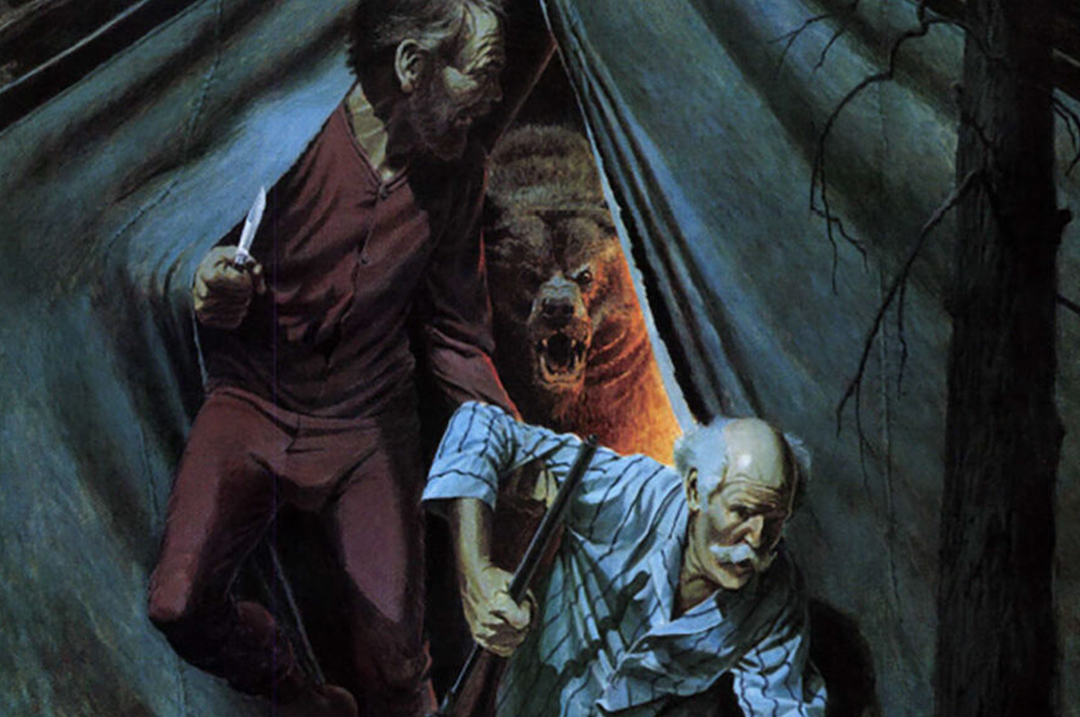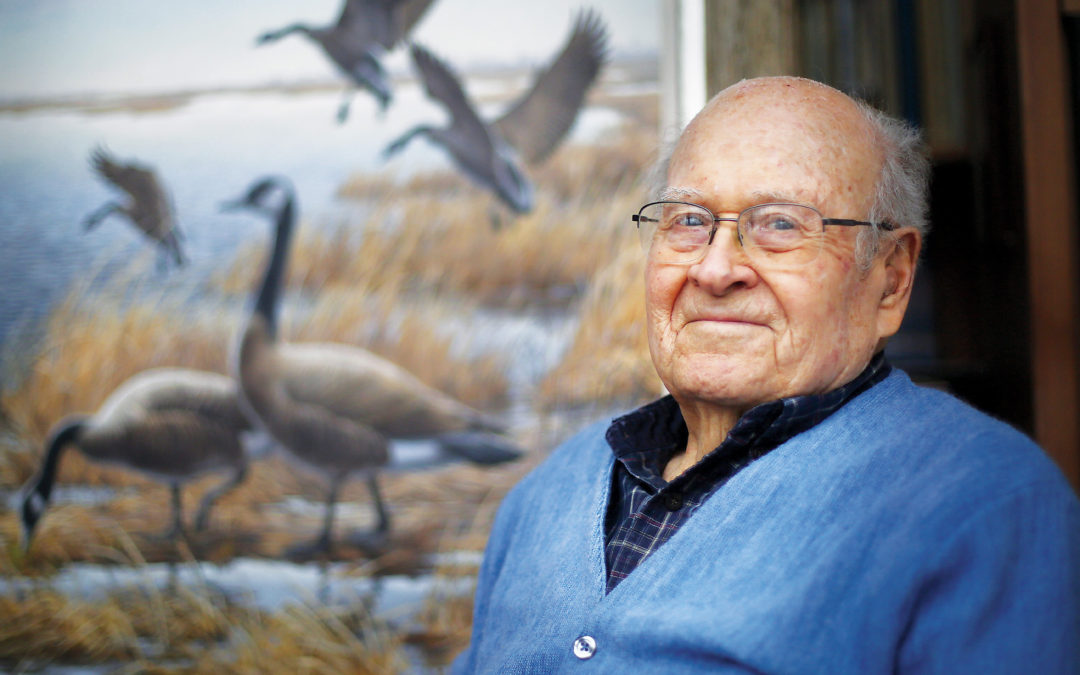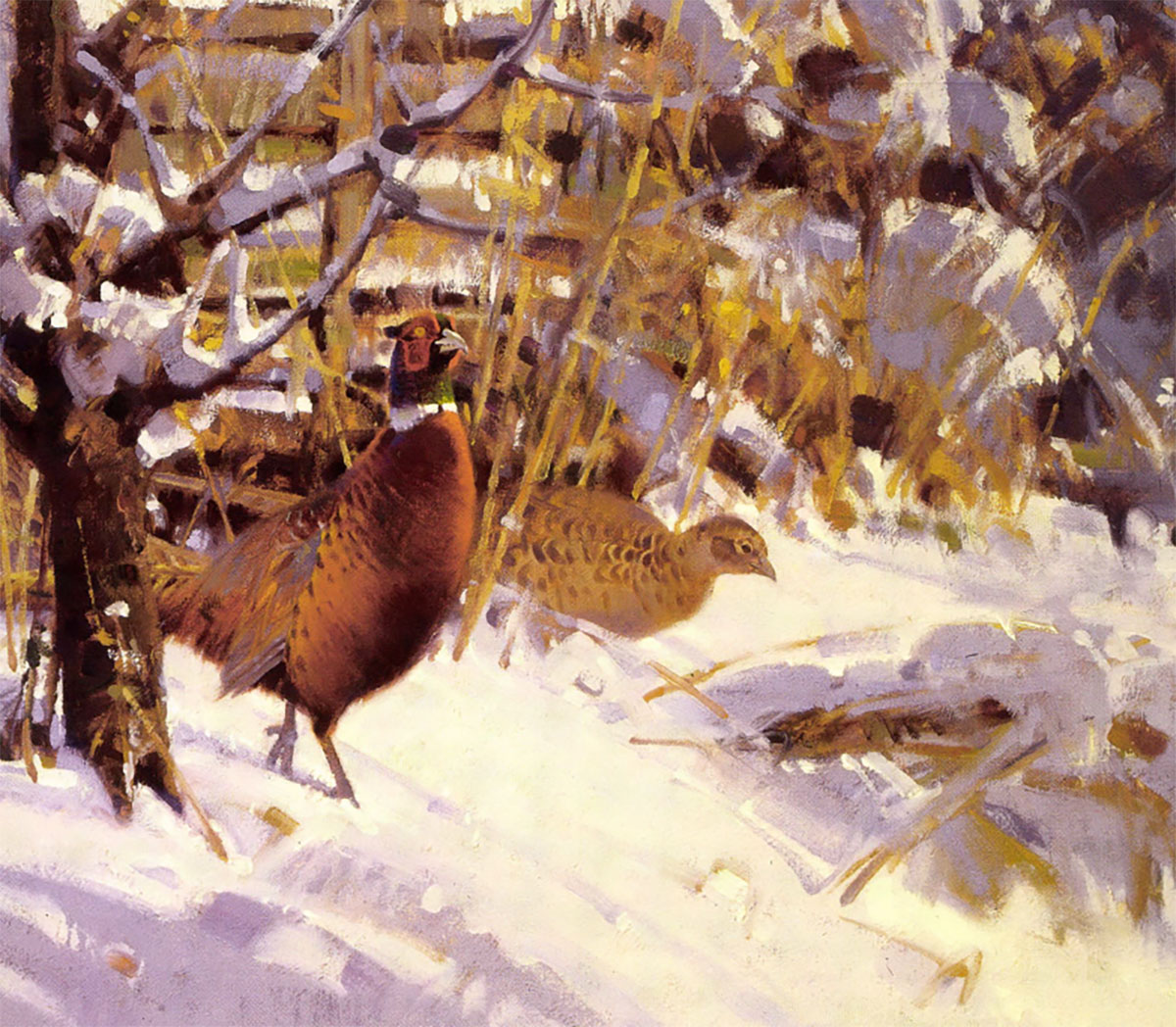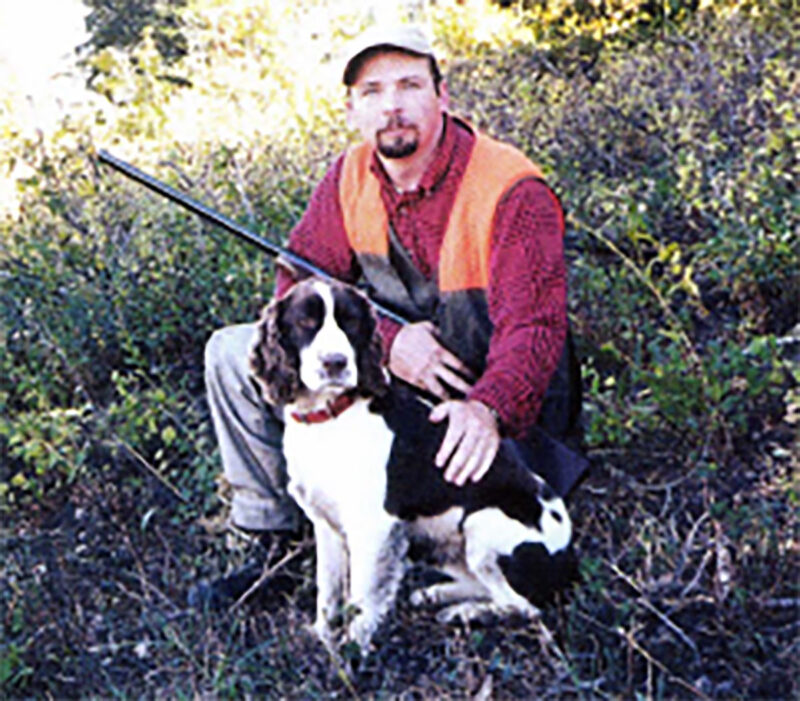 Peering expectantly from his studio window as if to see something that wasn’t there the day before, Dan Burr watches the sun rise above the Grand Tetons and slowly warm the valleys, hills and streams from which he draws inspiration. The easy-going artist enjoys the rugged beauty of his mountain surroundings, the solitude and sporting opportunities and especially the fly-fishing. Within a few minutes of his home in the Teton Valley of eastern Idaho, Dan can fly fish for rainbows and browns, or hunt grouse, waterfowl and whitetails, pursuits that he relives in his colorful oil paintings.
Peering expectantly from his studio window as if to see something that wasn’t there the day before, Dan Burr watches the sun rise above the Grand Tetons and slowly warm the valleys, hills and streams from which he draws inspiration. The easy-going artist enjoys the rugged beauty of his mountain surroundings, the solitude and sporting opportunities and especially the fly-fishing. Within a few minutes of his home in the Teton Valley of eastern Idaho, Dan can fly fish for rainbows and browns, or hunt grouse, waterfowl and whitetails, pursuits that he relives in his colorful oil paintings.
“I’ve got no business trying to paint a hunting or fishing scene unless I know what I’m doing,” he says. “I want to recreate a very personal experience, and knowing firsthand the subtleties and nuances of my subjects enables me to communicate authenticity to the viewer.”
Tim Pinson, owner of Angler Art & Gifts in Denver, knows all about Dan’s enthusiasm for hunting and fishing and his talent for interpreting his adventures on canvas. “He took my son and me fishing on Henry’s Fork last year and we had the time of our lives,” says Pinson. “Dan is like a little kid when he’s fishing. He gets so excited.”

Dan Burr painted Fish On from his memories of angling on the Housatonic River in Connecticut, where he worked as a commercial illustrator for several years.
It takes more than passion, however, to make a living as a sporting artist these days. Pinson, adds, “The most appealing thing about his art is the realism. He captures the essence of a scene. He has the ability to get the details right, from the crease in a hat to the lines on the face. His background as an illustrator has given him those skills.”
The 38-year-old artist spent many years developing those skills. Even though he showed artistic promise as a youngster, it wasn’t until he returned to college after serving a two-year mission in Spain for the Church of Jesus Christ of Latter-Day Saints that he began preparing for a career in art. “My father is a sculptor and painter, and when I was young I often watched him work,” Dan recalls. “I also saw the ups and downs of an art career, and I wasn’t sure that I wanted to go down that road So I tried different jobs, from working as the art director for a local newspaper to running my own sign company. But no matter what I did, I always came back to illustration. I guess I just gave in to what was natural!”
Dan grew up in the foothills of Mountain Green, Utah, a small community in Morgan Valley at the base of the Wasatch Mountains, where he fished a stream just across the street from the family home.” Both my father and grandfather were avid fly-fishermen. I was about eight or nine when Dad first gave my older brother and me some of his hand-tied flies, and I can still remember racing down to the river to try them out.”
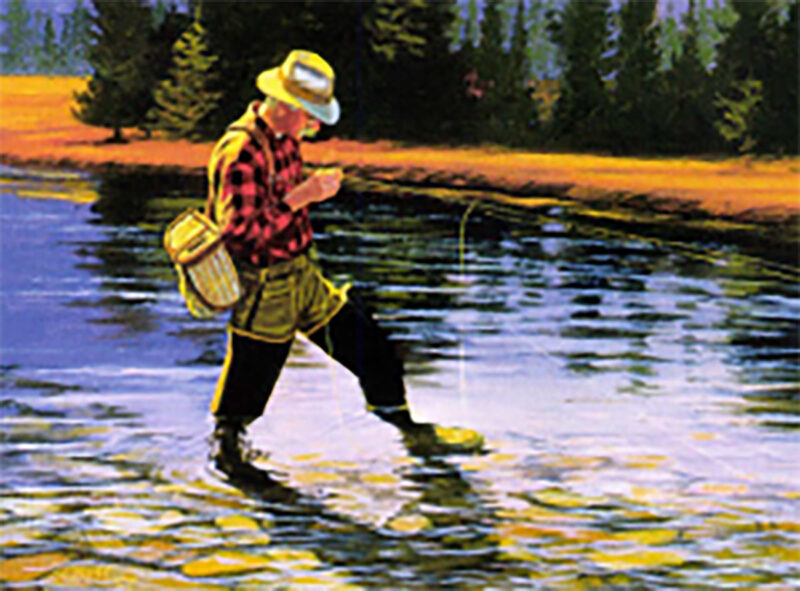
“I had my father and grandfather in mind when I did Golden Years,” Dan explains. “I love watching old guys fish, and I have so much respect for them.
In 1986, Dan enrolled in the art program at Utah State University, where he earned a B.FA with an emphasis in illustration under Professor Glen Edward s, a talented artist who would help Dan develop a style of painting reminiscent of the early sporting illustrators. Since boyhood days, Dan had always admired the artists who created classic hunting, fishing and adventure scenes for calendars and the covers of outdoor magazines in the 30s, 40s and 50s. “My favorites were all working illustrators — Russell and Remington, N.C. Wyeth — and I love the fishing art of Winslow Homer,” he says. “Some of the modern sporting artists I really admire are Ken Carlson, Eldridge Hardie and Bob Kuhn. To have hopes of following in the steps of that kind of tradition, I knew I had to go to New York.”
Dan was in his senior year at Utah State when the university’s art department was invited to participate in the Los Angeles Society of Illustrator’s student show. “We sent in our paintings and it seemed like weeks went by before we heard anything. Finally, the news came that I had won first place and a $1000 cash prize. For a graduating college student, it was a great financial boost and a big confidence-builder for me.”
With that confidence, Dan and his wife, Patti, left the familiarity of the High West and moved to Connecticut, where he would ride the train into New York City to peddle his talents. His relaxed, personable but confident, style served him well when approaching art directors and in a few weeks Dan had assignments from such major magazines as Reader’s Digest and Field & Stream. He also managed to set up a visit with Bob Kuhn at his home in Roxbury.
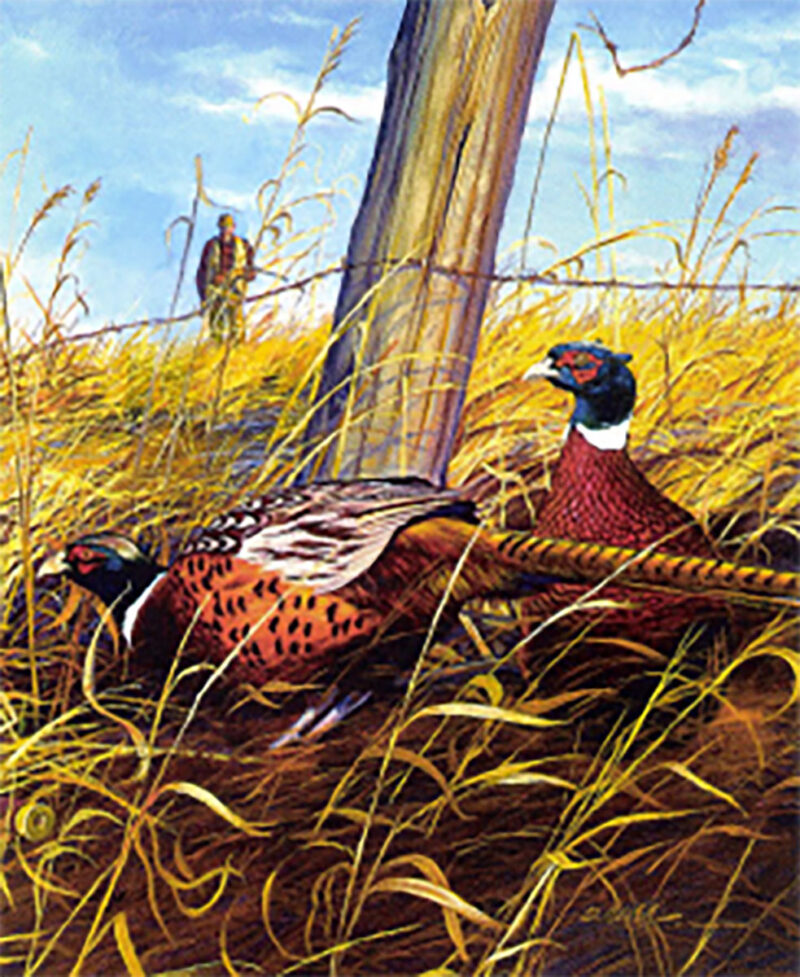
Double Trouble, which relives the day two roosters flushed at his feet while he was walking back to his car. “I didn’t get either one,” he recalls.
“Bob was very accommodating. He sat me down on a stool and asked me what I wanted to know about painting and wildlife. He was very encouraging and had positive things to say about my work. He’s a great guy; I have a mentor-like respect for him.”
Dan illustrated dust jackets for the young adult book market during his first years in commercial art. Although painting people was his strong suit, he was also asked to depict a wide variety of other subjects which, along with the demands and deadlines of art directors, proved invaluable in preparing him for a career in fine art.
While living in Connecticut, Dan took advantage of whatever sporting opportunities he could find, from fly-fishing for browns and rainbows in the Housatonic River to catching bluefish and striped bass off the coast of Rhode Island. And while he enjoyed his five years there, Dan and his wife, Patti, soon found themselves yearning for the high peaks and clear-water streams of the West.
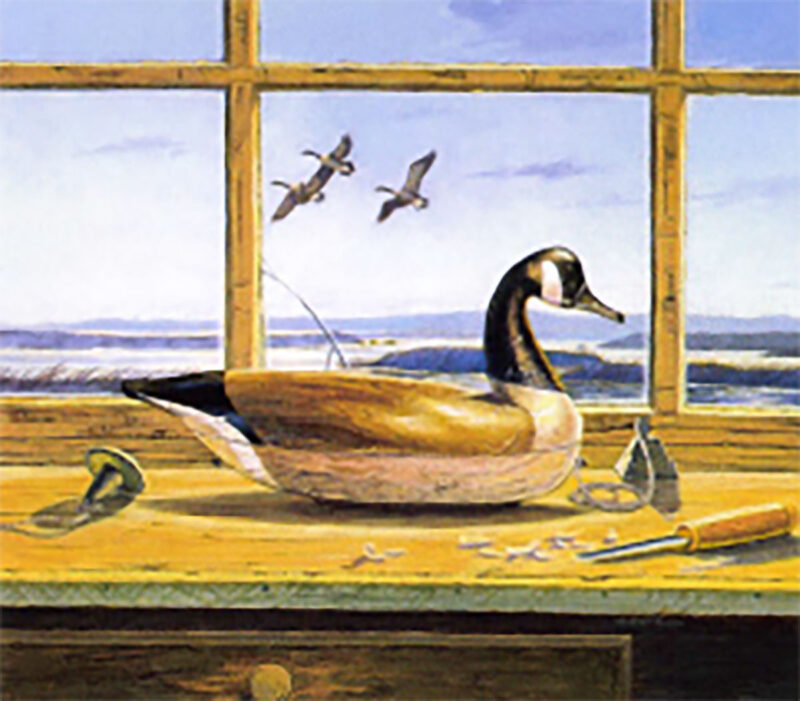
Illustration of a Canada goose decoy for a decorative plate.
“In 1994 we were visiting my parents at their home in the Teton Valley,” Dan recalls, “and one afternoon my daughter and I were walking along an old Union Pacific railroad track when I saw this wonderful meadow with a stream flowing through it. I remember distinctly thinking, ‘What a beautiful place for a home.'” Later that year the Burrs built their dream home overlooking the little trout stream, which glides through a lofty corridor of aspens and cottonwoods.
Today, the family, enjoys a life of quiet splendor on the 20-acre property. To find inspiration, all Dan has to do is gaze out his studio window at the magnificent Tetons less than six miles away. For hands-on research, it’s just a short stroll down a country road to a little spring creek where he can get his brook trout fix, almost on a whim. He can up the stakes with a five-minute drive to the Teton River where it meanders through agricultural fields in the valley. When he wants to feel the tug of a big rainbow or cutthroat, the South Fork of the Snake River is a pleasant 45 minutes away, through pastoral hills where abandoned homesteads and barns, tilted and weathered by wind and age, beckon to his artist’s eye.
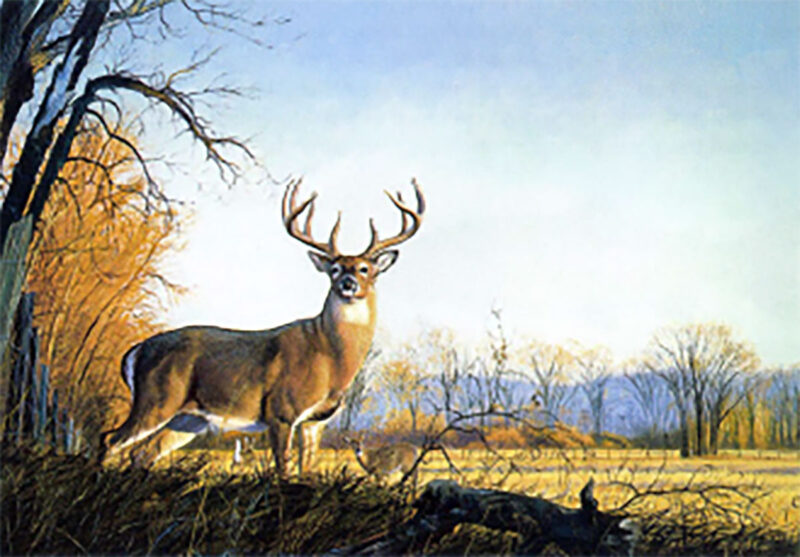
Something in the Wind is a recreation of the final seconds before the artist killed this handsome 150-class whitetail in a river-bottom field near his home.
“I’ve always loved this part of the country,” he says. “Our family visited the Jackson area every summer when I was young. My father would paint landscapes, and we’d end up camping all over the place and fishing the rivers and lakes. I can still remember three of us crammed in a little wooden boat and the water almost coming over the gunwale.” Dan continues, “I find it interesting that I started out painting animals as a child, then slipped into illustration and mass-market stuff, then evolved back into painting wildlife and the sporting scenes. But what’s never changed is my feeling about God’s hand in the creation of everything around us and in the many blessings that have come to me and my family.”
Dan still does magazine and book illustrations, though commercial art now accounts for only a small percentage of his work. “Researching and illustrating many different topics exposes me to a variety of things, and having to illustrate difficult or complex scenes continues to help me develop my skills.” And combining those skills with his outdoor experiences helps Dan relate to his steadily growing audience of hunters and fishermen.
Sportsman’s Gallery, which produces a distinctive catalog featuring more than a dozen artists handled by its gallery in Atlanta, has been promoting and selling Dan’s originals for years. “Dan doesn’t over-dramatize a scene,” says owner Michael Paderewski. “His use of light and color creates a mood that viewers find appealing.”
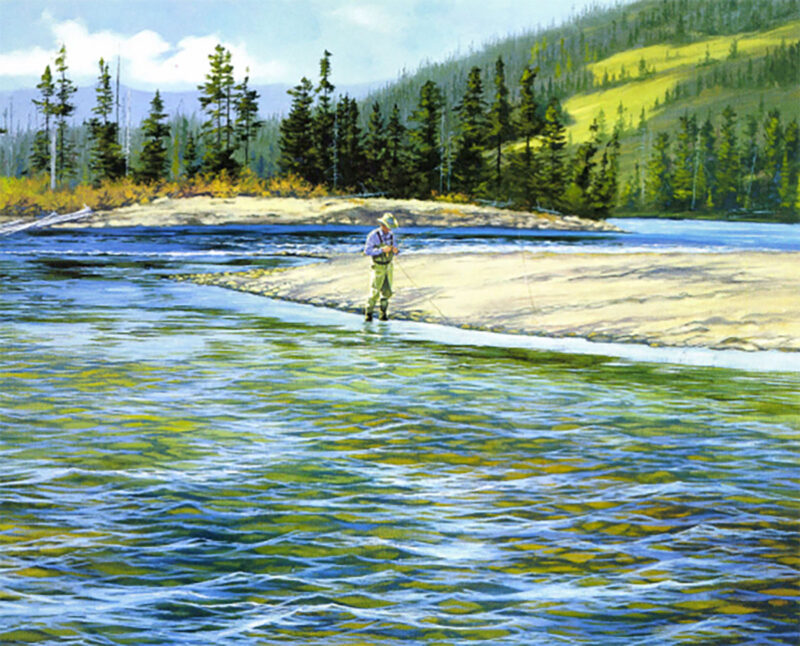
Big Water, which depicts a flyfisherman on the Madison, one of the West’s legendary rainbow trout streams.
Dan leans toward bright, almost brilliant, colors, something he traces to the great sporting artists of yesteryear. “They used colors that were incredible — like strong, contrasty blues and yellows that were almost shocking. The great Western artist William R. Leigh used to paint purple horses with yellow bellies — but the colors were obviously convincing to the eye. I once did a green moose, which was actually reflected light off the water and trees. But it worked for me, and it worked for the guy who bought my painting.
“Everyone says I’m an eternal optimist, and I wonder if that comes through in my choice of colors. Of course, dirt isn’t a very pretty color, and I guess I try to make everything more attractive.”
Michael Paderewski is particularly intrigued with Dan’s paintings of fly-fishermen on secluded wilderness streams. “Human interaction with the setting is one of his strengths,” he points out. “You can tell that he’s a fly-fisherman, that he understands the mechanics of the line and the cast. It’s apparent that he has done his homework.”
 Like his father and his grandfather before him, Dan enjoys tying his own flies and creating new patterns. Last year he came up with a tiny, thread-bodied fly on a #16 hook, which he used to catch a 22-inch brown trout on the South Fork of the Snake River. “We call it “Big Red” or “The Bead,” and it’s gaining fame in these parts, with a lot of guides looking for it. Most of the big fish I caught last year were on that fly.”
Like his father and his grandfather before him, Dan enjoys tying his own flies and creating new patterns. Last year he came up with a tiny, thread-bodied fly on a #16 hook, which he used to catch a 22-inch brown trout on the South Fork of the Snake River. “We call it “Big Red” or “The Bead,” and it’s gaining fame in these parts, with a lot of guides looking for it. Most of the big fish I caught last year were on that fly.”
Dan’s hunting heritage is just as strong. He grew up stalking mule deer in Utah’s Wasatch mountains, though in recent years whitetails have captured his interest, both as an artist and as an avid hunter who two years ago killed a 150-class buck. The wooded river-bottom near the Burr’s home is refuge for a large number of whitetails, and Dan takes a more-than-passing interest in their survival. When temperatures plummet far below zero and deer can lose more energy than they gain from browsing on natural foods, Dan will fasten the bindings of his cross-country skis and like some mythical Norseman, stride into the woods with a sled in tow to scatter wheat and barley for the animals.
“I never tire of watching and hunting big bucks, or searching for their sheds. And I can’t sit in a tree stand on a quiet morning and watch a buck move about and cautiously sniff the air without being moved by it — without wanting to recreate it in a painting,” he admits.
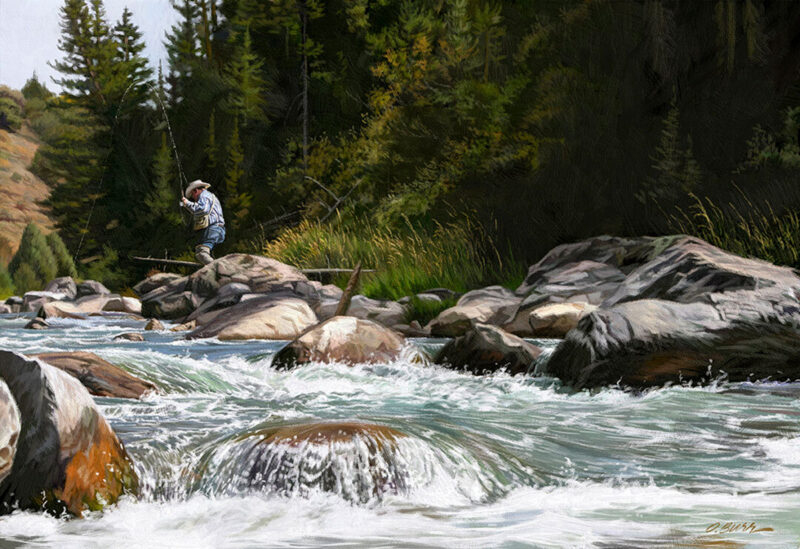
Says Michael Paderewski , “Technically, Dan’s knowledge and skill at painting big game anatomy, and particularly whitetails, is right on.”
D’Arcy Echols, noted custom rifle maker and big game hunting guide in Utah, commented “When I look at Dan’s paintings, I am reminded of a saying that “quality is innate and makes itself evident.” Of Dan’s work, my personal favorites are high desert landscapes with antelope; looking into the canvas, I can feel the wind, and taste the dust and dry sage.”
Spend a little time with the artist and you’ll understand where his desire for that kind of realism comes from. Dan loves the natural world, and it infuses him with an infectious optimism. We’ve shared many outdoor experiences, and whether it’s 10 degrees below zero in a duck blind on the Teton River or stair-stepping up steep hills in chukar country, he is always optimistic and reflective of the big picture.
Dan has that rare ability to capture the feeling of a certain time and place in his landscapes of hunters and fishermen. A few steps from where I sit typing, one of his oils graces a fireplace at the center of the room. The painting is a thoughtful reminder of a day we spent together. The amber hues recall the last minutes of an evening hunt in a setting familiar to me — a place that knew my father’s footsteps as well as my own.
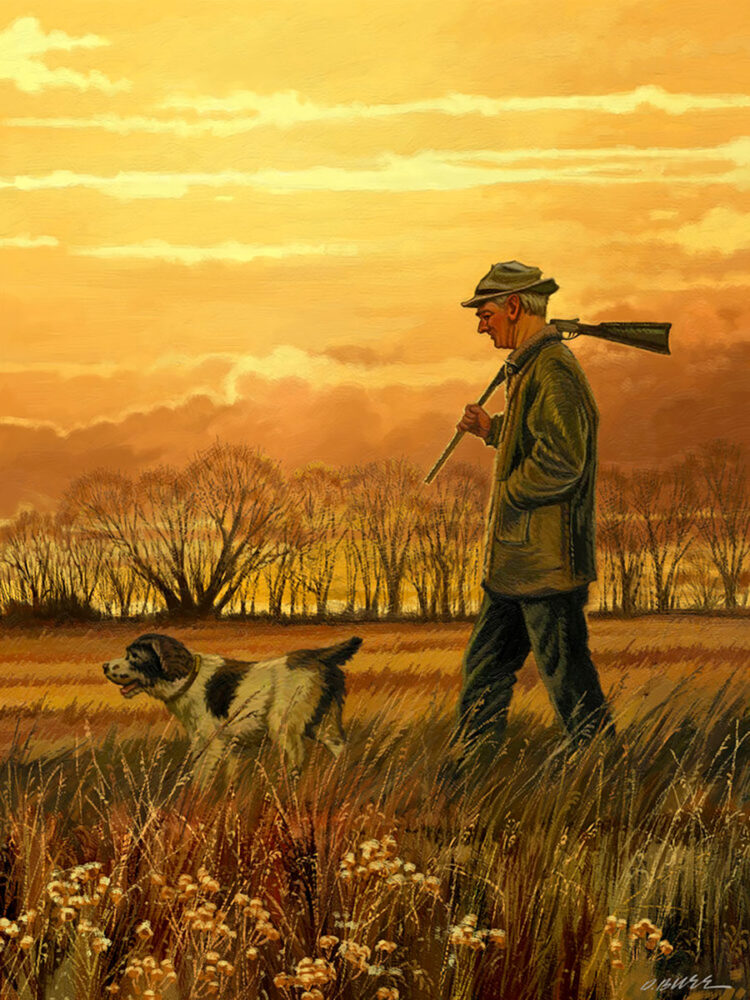 When I visited Dan in November, we planned what would become my last day of fishing in ’98. The drift boat was hitched to the car, lunches prepared and shuttle arrangements made. Dan grabbed his vest from a shaker peg in the back hallway, then paused in front of several fly rods. As if in his studio selecting a brush, he chose the proper tool for the job and soon we were off on another adventure that he would store away in his memory until that day when he would relive it for others in a compelling oil on canvas.
When I visited Dan in November, we planned what would become my last day of fishing in ’98. The drift boat was hitched to the car, lunches prepared and shuttle arrangements made. Dan grabbed his vest from a shaker peg in the back hallway, then paused in front of several fly rods. As if in his studio selecting a brush, he chose the proper tool for the job and soon we were off on another adventure that he would store away in his memory until that day when he would relive it for others in a compelling oil on canvas.
“Sometimes my paintings are based on a particular place,” he explains, “other times they’re places drawn only from my mind — of big bucks I’ve seen or great trout streams I’ve fished.”
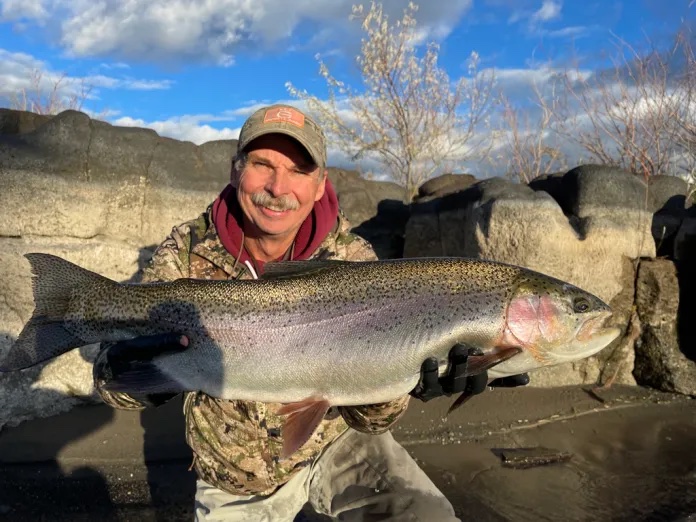 But always, Dan’s paintings reflect his passion for the outdoors, a passion that was passed down to him and that he, in turn, is passing on to his children. “Each day my son can hardly wait to get outside, or to come into my studio and see the new trout I’m painting. And my father, who’s far older than I but still a young man, said to me, “We’ve got a lot of fishing ahead of us — I can’t wait.”
But always, Dan’s paintings reflect his passion for the outdoors, a passion that was passed down to him and that he, in turn, is passing on to his children. “Each day my son can hardly wait to get outside, or to come into my studio and see the new trout I’m painting. And my father, who’s far older than I but still a young man, said to me, “We’ve got a lot of fishing ahead of us — I can’t wait.”
 You’ve come to fish at the right time, selected the correct lure, made the perfect presentation, and the fish of your lifetime has taken your offering. Your chances for fighting and landing it are now as strong as the weakest link in the line between your reel and the fish. Is now the time to wonder whether the materials you selected and the knots you tied were the best choice for the conditions?
You’ve come to fish at the right time, selected the correct lure, made the perfect presentation, and the fish of your lifetime has taken your offering. Your chances for fighting and landing it are now as strong as the weakest link in the line between your reel and the fish. Is now the time to wonder whether the materials you selected and the knots you tied were the best choice for the conditions?
In Fly-Fishing Knots and Connections, legendary fly fisherman Lefty Kreh tells anglers everything they need to know about what may be the most crucial aspect of successful angling-the connections between the reel, backing, fly line, leader, and tippet. Buy Now

